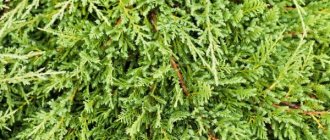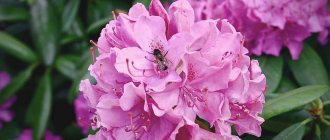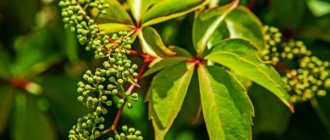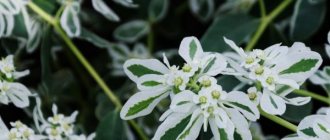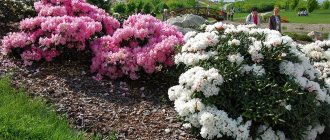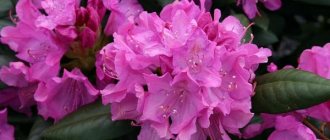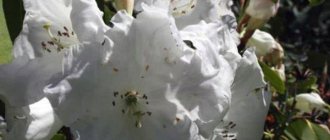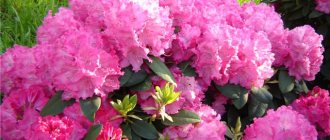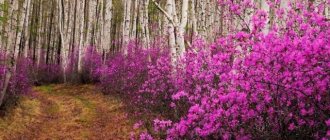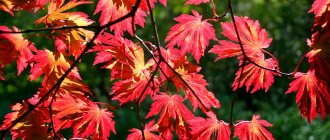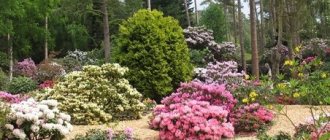General information
Deciduous Japanese rhododendrons - representatives of the Heather family - grow up to 2 m in height. There are about 12,000 varieties of the crop, which were bred by European breeders. Depending on the variety, rosewood buds bloom in April-May. Flowering continues for a period of 2 weeks to 2 months. In the description of the culture, it is noted that on one Japanese rhododendron bush up to 400 flowers with a diameter of up to 8 cm are formed. During this period, the plant is strewn with fragrant corollas so that no branches, foliage, or crown are visible. The Japanese salmon rhododendron blooms especially beautifully; its high winter hardiness makes the variety popular in gardens in the Moscow region.
Deciduous Japanese rhododendrons form inflorescences of 6-12 corollas. After flowering, fruit boxes with miniature seeds-grains are formed. In one place, the culture can grow up to 40-50 years, the life expectancy of individual representatives of the genus reaches 100 years.
Application in landscape design
Deciduous rhododendron: varieties, planting and care
Due to its unpretentiousness and bright flowering, Japanese rhododendron is widely used in landscape design.
To find the correct application, you need to know the height, shape and size of the leaves, the size and color of the flowers, and the length of the flowering period. You should also know how each specific variety tolerates different weather conditions.
Many experts recommend planting rhododendron in groups with other trees and flowers to provide a picturesque view of the site.
Growing conditions
The natural habitat of deciduous rhododendrons is southern slopes in the form of sunny areas among shrubs and grasses. The culture is often found on mountainous terrain. The flower is light-loving, but does not tolerate midday sun rays. Rosewood bushes are planted near fences or buildings, under the crown of deciduous and coniferous garden inhabitants, among ornamental vegetation, to ensure a balance of light and shadow during the day.
What does Japanese rhododendron look like?
The culture prefers relatively acidic soils with pH values of 6-7.5. Well-warmed soils with a southern slope are suitable for growing. Deciduous rhododendrons are moisture-loving, but the roots are afraid of flooding, so having well-drained soil is important. In the middle zone, it is advisable to shelter rosewood bushes from winter winds, although the crop is frost-resistant and can withstand temperatures of -26-29°C without damage.
Preparing for winter
Japanese salmon rhododendron is frost-resistant and can survive the winter without shelter. But no one can predict whether winter will be snowy. Therefore, it is better to play it safe and prepare the plant for wintering. Young bushes up to two years old also need obligatory shelter.
Young rhododendron should be covered for the winter
In addition to shelter, rhododendron also needs to receive moisture in winter. To do this, in the period before frost (from early autumn), you need to water the plant every other day, with about 12 liters of water. After this, a thick layer of pine bark mulch is laid. When frost occurs, the lower branches are sprinkled with compost. You can use pine needles or peat.
To protect the tree from snow and sun, you need to carefully tie the branches together without damaging the buds. Drive pegs around the bush and attach covering material to them. It could be burlap, agrotex, or even a homemade “house” made of polypropylene.
When the frosts stabilize and the temperature on the thermometer scale does not fall below -10 degrees, the shelter must be removed to prevent overheating. The cover must be removed gradually so that the sun does not burn it. It is enough to allow air access.
If you do everything consistently and with love, your diligence will be rewarded with the lush flowering of Japanese rhododendron. Replenish your garden with this unique shrub; with proper care, it will delight you year after year.
Varieties
Many varieties of rosewood are cultivated in gardens, mostly in group plantings.
Japanese salmon rhododendron
The culture is the leader in popularity among fans of ornamental plantings with abundant flowering at the beginning of the warm season. Japanese salmon rhododendron grows up to 2 m. Lush inflorescences of 6-12 brightly colored corollas bloom in May-June with a flowering duration of about 3 weeks. The bright green lanceolate foliage, 10-12 cm long, acquires a fiery hue by the beginning of autumn.
Japanese salmon rhododendron is in demand not only because of its impressive color and delicate aroma of its petals. The winter hardiness of the variety allows it to be used to decorate garden landscapes in regions with relatively harsh climatic conditions.
Cream
The variety is relatively low-growing, the bushes reach a height of 1.2-1.5 m. The petals are cream-colored with a bright yellow core. The plant stands out for its lush flowering with large corollas of 10-12 pieces. in inflorescence. The rich green leaves turn yellow-purple in autumn. Cream Japanese rhododendron grows well in areas with large differences in elevation and is often used in terraced landscape compositions.
Babushka
A dwarf plant, the height and width of an adult bush is about 50 cm. The crop belongs to the group of semi-evergreen representatives of the family. Prefers partial shade, belongs to frost resistance zone 6. Blooms with semi-double carmine-pink corollas. In terms of intensity and brightness of the color of the petals, it is second only to the red Japanese rhododendron. By autumn the foliage takes on a golden color.
Schneeperle
Azalea Schneeperle grows very slowly. A 10-year-old bush reaches a height of only 35 cm with a width of 55 cm. This Japanese rhododendron is an early bloomer, snow-white lush flowers d4-5 cm begin to bloom in mid-April. The plant is used to form borders in multi-row decorative plantings. Frost resistance – up to -29°C.
WhitePrince
The Snow White Prince variety reaches a height of up to 2 m. It blooms with white, sometimes with a soft pink core, corollas 6-8 cm in diameter. It prefers areas protected from the wind and direct rays of the midday sun. The crop is of average winter hardiness; covering agricultural technology is required in frosty winters.
Rhododendron japonica WhitePrince
Yellow
The branched shrub grows up to 3 m wide with an adult plant height of about 1.5 m. It blooms in May with yellow corollas with an orange spot. Each inflorescence contains about 20 flowers. The crop is poisonous, including all parts of the foliage, roots, petals and seeds.
Reproduction
Japanese rhododendron can be propagated in several ways: cuttings, layering and dividing old bushes.
When cutting in the spring, a branch 15 cm long is cut and several lower leaves are removed from it. The cutting is placed in moist soil, in which it will remain for 2-3 months until rooting. If the root system has developed well enough, then in August you can transplant it into open ground. Otherwise, it is better to postpone planting until next year, and move the container with cuttings to a bright room with a temperature of 8-12 ° C.
Reproduction is possible in three ways
If the bush has a large number of branches, propagation can be done by division. To do this, the bush is dug up and, with a sharp shovel, divided into several separate parts with its own roots and shoots.
The easiest way is propagation by layering. A healthy branch is selected and bent to the ground. The bend area is sprinkled with soil. The young plant separates in autumn or spring.
Winter hardiness
To know which varieties of rhododendrons are good for growing in regions with frosty winters, it is worth checking their winter hardiness.
Rosewood varieties that can withstand temperatures down to -42°C:
- Colden Lights;
- Rosy Lights;
- White Lights.
Crop varieties that can withstand frosts down to -32°C without damage:
- Roseum Elegans;
- PJM Elite;
- Mount Saint Helens;
- Nova Zembla.
At the same time, the EnglishRoseum variety can withstand seasonal temperature conditions down to -34.4°C, and Karens - only up to -31°C.
Flowering and photo
The shrub blooms in May-June and is pleasing to the eye for 3-6 weeks. Large flowers, with a pleasant smell and invariably rich color, open into bells 6-8 centimeters in diameter. Each brush blooms from 6 to 12 inflorescences. Although coral is considered the main color of Japanese rhododendron, the range of shades also includes yellow, red, and orange tones. An incredible celebration of color!
You can visually see the Japanese rhododendron in the photo below:
Planting and care
Bushes that are 3-4 years old are planted, taking into account that the annual growth is 2-10 cm, depending on the variety.
Choosing a site and preparing for planting
Planting and caring for Japanese rhododendron are carried out in accordance with the agricultural practices of a crop native to a humid marine climate. The area for the rose tree is chosen to be slightly shaded, since the plant does not tolerate the scorching rays of the sun. In their natural environment, rhododendrons grow in a complex substrate with an abundance of plant inclusions in the form of needles, foliage, and branches. It is necessary to prepare fertile soil with the addition of peat, rotted pine needles, and clean river sand for looseness. If there is a close location of groundwater, it is important to build high beds and ensure high-quality drainage.
Before planting, young rosewood bushes need to be hardened off for 7-10 days. The tubs with the plant are taken out into the fresh air, left in the shade for 20-30 minutes, increasing the time interval daily.
The nuances of planting a plant
Planting a rose tree is carried out in the following sequence:
- Dig a hole 50 cm deep.
- At the bottom of the planting pit, a drainage layer is constructed using vermiculite, expanded clay or crushed stone.
- Peat, pine needles, and any mulch are added to the removed soil. Complex mineral fertilizer is applied at the rate of 30 g/bush.
- Part of the prepared soil mixture is poured onto the drainage layer, the root ball is placed, covered with substrate, watered abundantly, and mulched.
When planting Japanese rhododendron, you must not bury the root collar of the seedling below the ground level.
When planting a rose tree, it is worth remembering that you cannot bury the root collar of the seedling below the ground level.
Watering and fertilizing
Deciduous rhododendrons require regular, abundant irrigation. When there is a lack of moisture, the leaves wrinkle, become dull, and this gives a signal about the need for watering. A generous layer of mulch will save you from critical drying out of the substrate under the bushes during the dry period. Feed the plant once a season with complex fertilizer for flowering shrubs at the rate of 10 g/m².
Trimming options
The bush forms a rounded shape on its own, so it does not require much pruning. If necessary, the following types of procedures are performed:
- sanitary pruning. In the spring, remove branches damaged in winter; during the summer, remove branches that are broken or damaged by diseases/pests;
- formative. Performed before budding to rid the bush of bare shoots and create a symmetrical crown;
- rejuvenating. Carried out in the summer after the flowering phase, it is performed to stimulate the development of shoots on which next year’s flower buds will be formed. To do this, shorten the shoots by 20 cm.
After flowering, it is necessary to cut off the wilted inflorescences; this helps to accumulate the potential for the development of the bush and preserve the decorative appearance of the plantings.
Preparing for winter
Winter-hardy varieties of crops do not need additional shelter; you just need to add mulch with a layer of 20-30 cm. Semi-evergreen members of the family should be covered with agrofibre. The breathable material prevents the seedlings from freezing during dry winters with little snow. To do this, build a frame over the bush and cover it with prepared fabric. Before wintering, the plants are watered with water at the rate of 6-10 l/bush, having previously dissolved potassium sulfate (6 g) and superphosphate (8 g) in it.
How to plant Japanese rhododendron
Japanese rhododendron has good frost resistance, so its cultivation is widespread in the western part of Russia and the Urals, but the plant will not take root in all regions of Siberia.
Preparing the seedling and site
Rhododendron Nova Zembla
The seedlings are kept in water until all air bubbles float to the surface. For good survival and strong immunity, the roots are treated with growth activators.
The planting area should be slightly shaded. You need to choose northern places, for example, you can plant a bush next to a building on its northern side. Planting is carried out in fertile, loose areas with high acidity. Groundwater must pass at a depth of at least a meter.
Important! It is not recommended to plant rhododendron next to maple, linden, elm, poplar, linden and willow. Due to the same level of root systems, competition for nutrients will arise. Larch, oak, pear, apple and pine will be good neighbors.
Step by step landing
The bush is planted in open ground in the spring immediately after the end of frost, in April or May. However, autumn planting is also practiced, which can be done from September to November.
First, you need to dig holes about 40 cm deep with a diameter of at least 60 cm. A substrate of loamy soil and peat is poured into the bottom. Seedlings are placed on top of the layer, covered with earth and compacted well.
It is necessary to plant the seedling so that the root collar is at the level of the ground surface. Then each bush is watered generously with settled water at room temperature. It is necessary that the water thoroughly moisten the soil to a depth of at least 20 cm. After this, begin the procedure of mulching the soil. Sawdust and leaves can act as mulch.
Important! If only one seedling is planted, the winds can damage the branches of the tree. Therefore, you need to choose a site next to buildings or build a wooden support to which you can tie the trunk.
Diseases and pests
Flower pests and ways to combat them:
- spider mite It feeds on the sap of the plant, causing the leaves to fall off. Treatment with special preparations is required, including Agravertin, Diazinon;
- aphid. Infection with this parasite can cause fungal diseases. Spraying with fungicides is required;
- mealybug. It sucks the juice from the leaves, which causes the branches to wither. It is necessary to treat the bush with Karbofos.
To prevent fungal diseases, treatment with a solution of Bordeaux mixture is recommended. If the soil is not acidic enough, the crop is affected by root rot. It is necessary to add peat and pine needles; solutions of potassium sulfate, colloidal sulfur and ammonium nitrate also help well.
How to grow from seeds?
If the Japanese rhododendron has captivated you so much that you are ready to start growing it yourself out of nothing, then you will have to be patient. Only in the second year can the plant be planted in open ground, but it will not begin to bloom soon. If difficulties do not frighten you, then at the very beginning of the year it is time to start working.
The period from January to March is the right time to sow seeds.
Optimum temperature and air humidity: within 15-18 degrees and 80%. In nature, rhododendron prefers acidic soils, so choose a mixture of pine needles (pine/spruce) or acidic peat in equal proportions.
The soil should be sufficiently moist both during sowing (it should be watered several days before) and after it. But watch out for fungal diseases!
For good growth and development, seedlings need light. Lots of light. Just under no circumstances expose them to direct sunlight, this will simply burn them. Urea, superphosphate and potassium sulfate are another component of future rich-colored success.
Do not forget to also loosen the mail, promptly get rid of weeds and protect from pests.
The grown seedlings should spend the summer outdoors in partial shade. With the beginning of autumn, they should be returned back indoors, where they will gain strength until next spring.
Tips for testing the germination of Japanese rhododendron seeds can be seen in the video below:
Plant care
Choosing a place for a plant
When choosing a site for planting azaleas, keep in mind that they do not like stagnant and excessive moisture. The place should be well lit, but only direct sunlight is not permissible. You can grow bushes under the shade of trees.
What should the soil be like?
To plant azaleas, you need a special substrate with high acidity, moisture and air permeability with a high organic content.
- If the soil on the site is sandy, then add peat, leaf humus and rotted compost to it.
- If the soil is clay, then loosen it with sand and peat. Proceed similarly in the presence of heavy soil.
Landing
Planting activities should be carried out in spring or summer. Procedure:
- Prepare holes for planting. The size must be large so that the seedling fits with the earthen ball. Depth 50 cm and width 70 cm.
- Place a drainage layer 15-20 cm thick at the bottom of the recess. Small pebbles and gravel are suitable for this.
- Water the seedlings thoroughly and remove them from the container without damaging the root system.
- Add peat and fertile soil to the drainage layer.
- Place the seedlings in the planting holes and sprinkle with soil mixture, compacting slightly.
- Sprinkle the ground around the plant with mulch to prevent moisture evaporation. Use sawdust, pine needles and tree bark.
Temperature
In summer, temperatures should be 22-25 degrees, and in winter – 14-16 degrees. If the temperature conditions are observed, the buds will ripen, and, consequently, the plant will bloom profusely.
Watering
Azaleas suffer from drying out of the earthen coma, but waterlogging also has a detrimental effect on the condition of the roots. It is worth watering alternately - in the pot and in the pan, using only settled soft water.
Feeding
In the fall, apply special fertilizers designed for azaleas. Carry out such events once every 10 days. In addition, watering is required to acidify the soil (5 g of citric acid per 1 liter of water). Once every 14 days, water the crop with a mixture of acidic peat and water.
Trimming
It should be done at the end of flowering. Using sharp pruners, remove all damaged and wilted shoots. Trim the remaining branches partially throughout the bush to form the correct shape. Treat the cut areas with varnish.
Transfer
If you grow a plant at home, it will require replanting every 2-3 years. Procedure:
- Prepare a nutrient mixture for the flower. To do this you will need the following components:
- charcoal;
- river sand;
- pine bark;
- perlite
- Dissolve Kornevin in water and immerse an earthen lump of flower in the solution for 30 minutes.
- Remove the azalea and wait for excess water to drain.
- Place the plant in the center of the new pot and evenly sprinkle the roots with soil, adding it to the sides of the lump and tamping it down a little.
Sources
- https://dachadizain.ru/derevya/rododendron-yaponskij-lososevyj.html
- https://mrsad.ru/dekorativnotsvetushhie/rododendron/vidy-rodod/yaponskii.html
- https://dacha.expert/sadovye-rasteniya/mnogoletnie/rododendron/sorta-ro/gejsha-yaponskaya.html
- https://usadba.guru/cvetovodstvo/kustarniki/rododendron-yaponskiy.html/
- https://dachnaya-zhizn.ru/rododendron-listopadnyjj-posadka-i-ukhod
- https://villaved.ru/komnatnyie-tsvetyi/tsvetushhie/rododendron-yaponskij.html
[collapse]
